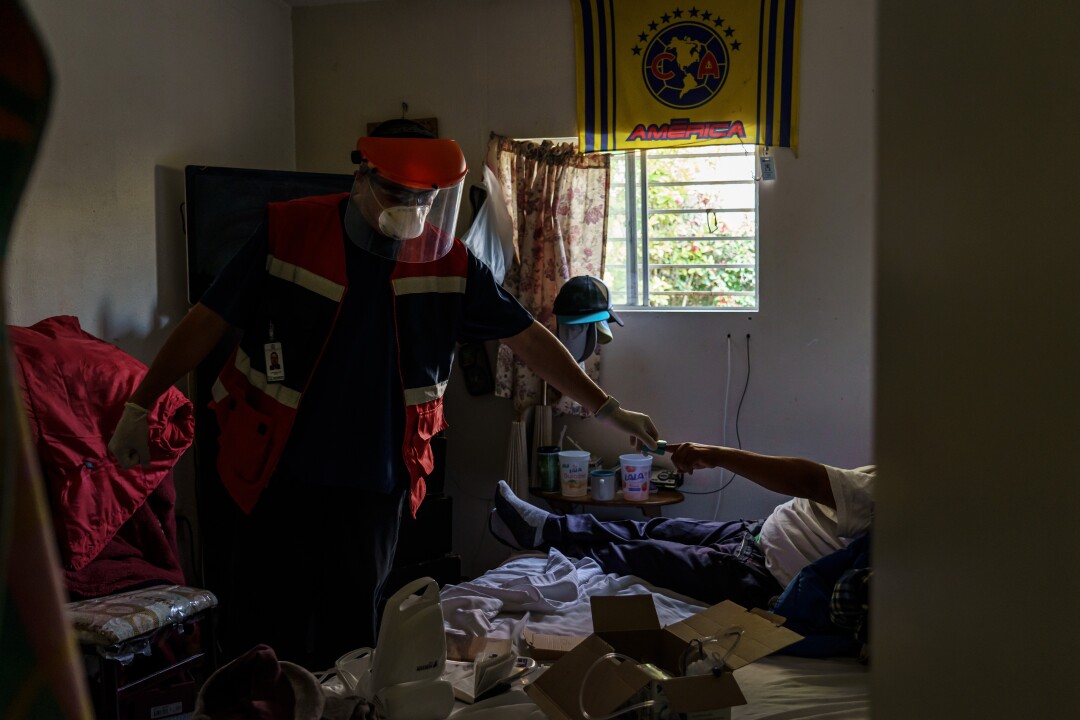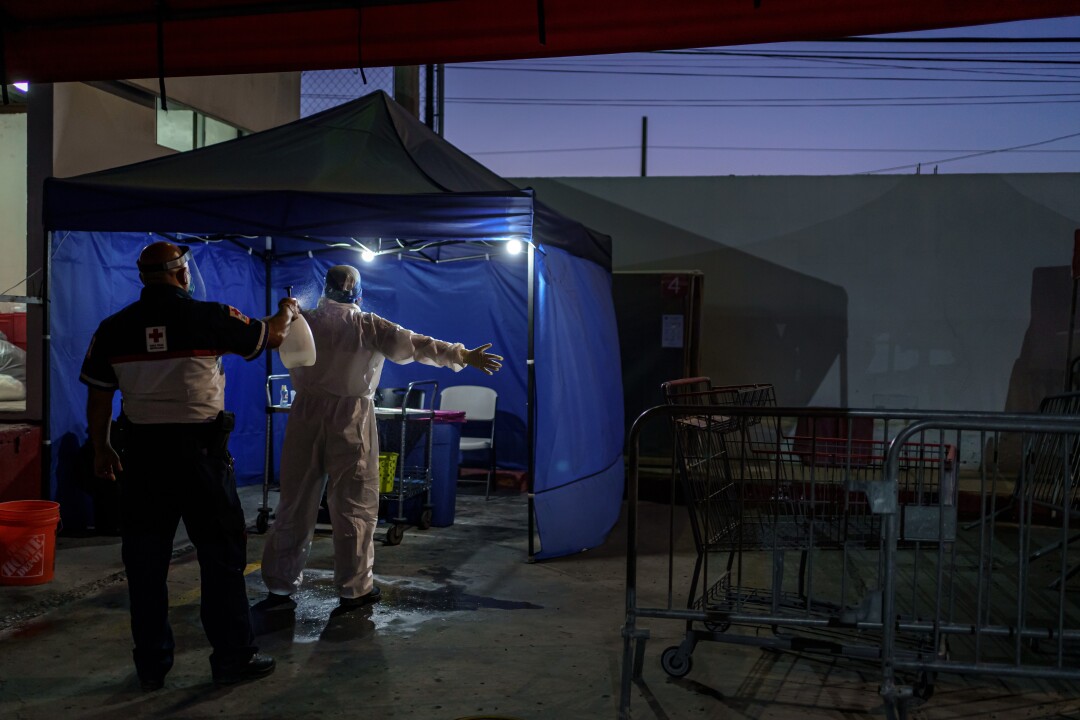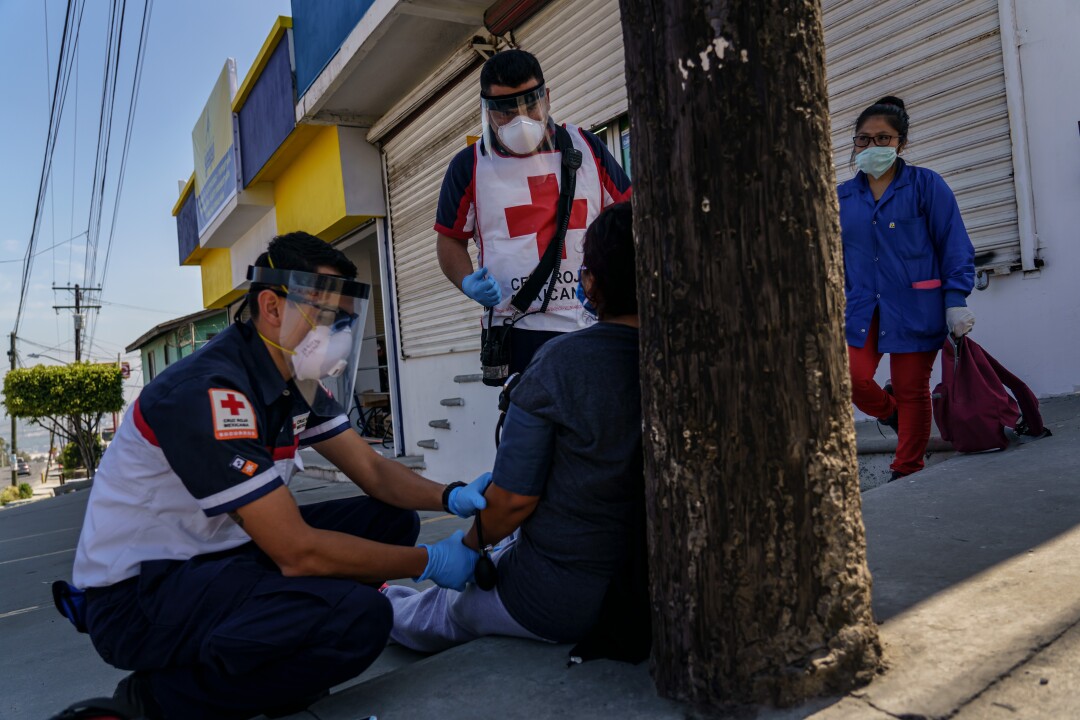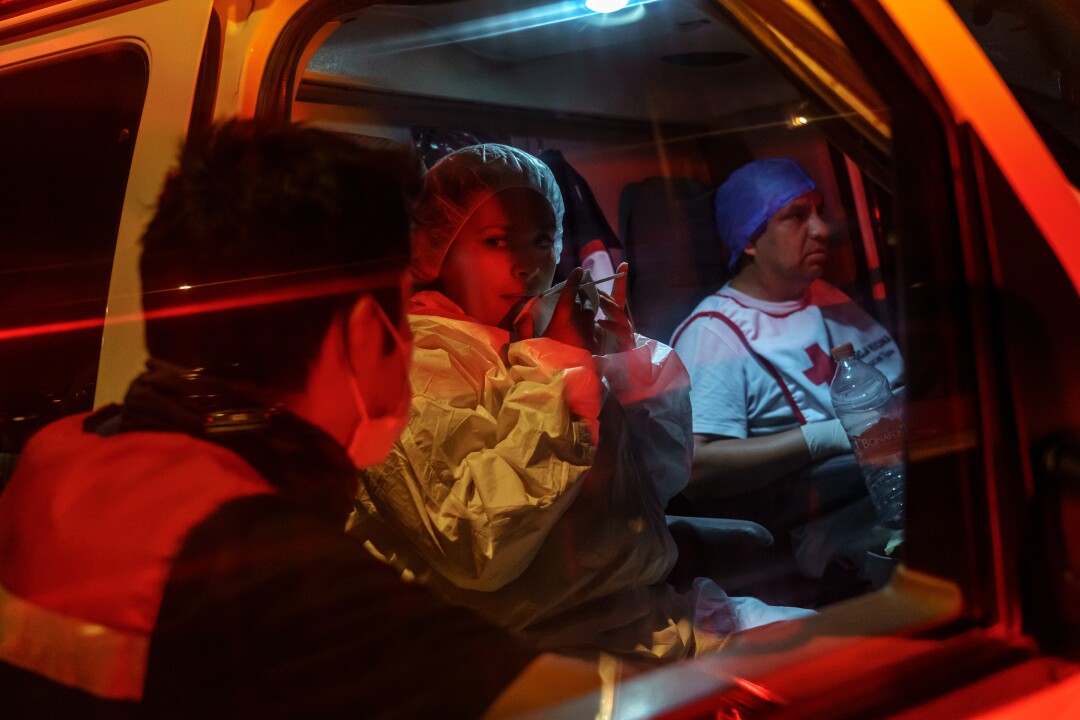In cities across Mexico, morgues are full, funeral homes are jammed and crowded hospitals are turning patients away.
“My father is in a black bag in the back of that brown hearse,” said Gabriela Jacomé, a 43-year-old house-cleaner waiting outside the San Nicolás Tolentino cemetery in Mexico City on a recent morning.
Vehicles carrying COVID-19 victims were grid-locked at the entrance along a main drag marked with yellow signs warning: “High risk of contagion!”
“We have to wait outside for hours to get in to pay final respects,” Jacomé said.
Advertisement
Advertisement

Dr. Alan Muro places a pulse oximeter on the fingertip of a patient exhibiting COVID-19 symptoms, to measure the oxygen saturation rate, in the Ejido Matamoros neighborhood of Tijuana, Mexico, on April 29, 2020.
(Marcus Yam / Los Angeles Times)
Such scenes are difficult to square with the country’s official death toll: 4,767 as of Friday.
Government authorities have long acknowledged that many cases are not counted because they have not been confirmed by testing and just how many remains a mystery.
There are clues. A review of 120 death certificates provided by a worker at a crematorium in the northern border city of Ciudad Juárez showed a total of 63 listed “probable COVID-19" as the cause of death. Another 30 named pneumonia or other respiratory ailments often associated with coronavirus.

Funeral home workers transport a corpse into their van, to take it out of Tijuana General Hospital, in Tijuana, Mexico, on April 25, 2020.
(Marcus Yam / Los Angeles Times)
Only 12 listed COVID-19 as the confirmed cause, meaning that only those cases would become part of the official count.
Advertisement
The widespread belief that Mexico’s official death toll is artificially low — and the inability of the government to correct it — has become fodder for critics of President Andrés Manuel López Obrador as the country of more than 120 million begins to reopen its economy. He recently complained: “They suggest we are hiding the dead.”
Dr. Alejandro Macías, an infectious disease specialist who headed the country’s response to the swine-flu epidemic a decade ago, said he had no doubt there is undercount.
“I don’t think it’s a question of bad faith,” he said. “But the official figures aren’t complete.”
Health authorities in three northern border states — Baja California, Tamaulipas and Chihuahua, where Juárez is located — have also challenged the government’s count.
“The official numbers are very low according to what we are seeing and experiencing,” said Dr. Pablo Villaseñor, who treats coronavirus patients at the General Hospital in Tijuana.
Villaseñor said he and his colleagues have counted more than 200 coronavirus deaths at the hospital, one of several treating pandemic patients in the sprawling city of 1.8 million.
The official death toll in Tijuana as of Friday: 402.
Yet things have gotten so bad that the city’s morgue has run out of refrigerator space for bodies.

Mary Londe Hernandez, center, kneels on the floor and prays, as Red Cross paramedics transport her husband, Eduardo Dionisio Molina, 41, who has symptoms related to COVID-19, to a nearby hospital from their home in the Ejido Matamoros neighborhood of Tijuana, Mexico, on April 29, 2020. Molina gasped for air and kept repeating in a high pitched voice, “I don’t want to go alone, I don’t want to go alone,” as he teared up while laying on the stretcher.
(Marcus Yam / Los Angeles Times)
“They’re putting them in the hallway and covering them with tarps,” said a worker from a nearby hospital who was waiting outside the morgue with a body.
Advertisement
The employee, who spoke on the condition of anonymity because she was not authorized to talk to press, had been there for hours because the facility was full.
Bodies also stacked up on the floor at the Grupo Funerario Monte Ararat, located in the center of the city, directly next door to a butcher shop, according to city and federal officials.
Tijuana city inspectors closed the establishment last week.
“At the time of the physical inspection, the inspectors realized the business had no cold room in which to keep the bodies and there were several bodies on the floor in cardboard boxes,” said Adolfo Garcia Dworak, a Tijuana city official.
The owner could not be reached for comment.
Baja California Gov. Jaime Bonilla insisted that the state government was reporting accurate numbers.
But even he has clashed with the federal government over coronavirus figures, accusing the federal health ministry of intentionally hiding the true figures.
During his daily morning coronavirus briefing streamed live online on April 17, Bonilla took issue with the federal government’s outdated reporting of numbers and called for them to update their data. At the time, the reported state death toll was pegged at 72, but the federal government was only reporting 33 deaths.
“Someone’s not telling the truth here,” said Bonilla about the discrepancy. Bonilla said he knew the president, with whom he is very closely aligned politically, was very concerned about the issue because state leaders needed to know what to expect.
“Here in Baja California, we are very well-informed, make no mistake, we are going to say things as they are, even if it hurts,” he said.
Advertisement
Testing shortages

Ulises Rodriguez, the Chief-on-duty, left, supervises a decontamination and removal of personal protective equipment after paramedics complete an emergency call or medical transport related to COVID-19, at the Red Cross base in Tijuana, Mexico, on May 2, 2020.
(Marcus Yam / Los Angeles Times)
In Mexico City, which has a population of 8.9 million and the most cases by far, officials said this past week that they were creating a special commission to determine how many people have likely died of COVID-19. As of Friday the official toll in the capital was 1,197.
Only people who have tested positive, while alive or after they die, are included in Mexico’s official count.
By comparison, the U.S. Centers for Disease Control and Prevention says COVID-19 can be included on death certificates if it is a “probable” or “presumed” cause of death, even without a laboratory diagnosis.
Mexico only began tallying “suspected” deaths linked to coronavirus in late April — and as of Friday the number stood at 462.
Most countries, including the United States, have struggled to count coronavirus victims, mostly because of a shortage of testing.
The testing rate in Mexico is among the lowest in Latin America at about 1,200 tests for every million people, according to the global statistics website worldometer.
The testing rate is more than 14 times higher in Peru and Chile, nearly 7 times higher in El Salvador and almost 3 times higher in Brazil.
The U.S. rate is more than 27 times higher, at 33,000 tests for every million people.

Red Cross paramedics Michael Zavala, 22, left, and Ivan Mora, 33, top, administer care to a patient that had already been to hospital for COVID-19 symptoms but because her oxygen saturation rate is still 99 percent, she was told stay at home and monitor their symptoms - as to not overwhelm the hospitals tasked with treating COVID-19 cases, in Tijuana, Mexico, on May 2, 2020.
(Marcus Yam / Los Angeles Times)
Advertisement
Dr. Hugo López-Gatell, the undersecretary of health and head of coronavirus policy, told reporters Thursday that the country had generally reserved testing “for cases sufficiently grave to be hospitalized” because that was all that was necessary to track to the spread of the virus.
He denied allegations that the budget-conscious administration of López Obrador — an early coronavirus skeptic who was relatively late to embrace social distancing — was purposely skimping on tests.
“We have money for tests,” López-Gatell said. “We have tests. More are coming.”
The official count of infections in Mexico reached 45,032 on Friday. But those numbers exclude 16,450 positive tests conducted by private laboratories and still under government review.
López-Gatell told reporters earlier this month that the number of infected could be eight times the official tally.
Tijuana’s overwhelmed doctors say severely limited testing is giving a false sense of security in a state where many residents have been lax about stay-at-home orders.
A doctor at IMSS-20, another coronavirus designated hospital in Tijuana, said the federal public hospital has 600 tests but no kits to run them.
She said the death toll in Tijuana is likely closer to 2,000 — and that’s a conservative estimate.
“I think there might be more because a lot of patients are dying from things like atypical pneumonia. That’s the official diagnosis when they can’t do the test,” said the doctor, who works specifically with coronavirus patients but asked that her name not be used because she is not authorized to speak with the media.
A Baja California health official who asked not to be named because he was not authorized to speak with the media said there’s a suspected 12,000 people infected with the virus across the state. Baja California’s state health department officially report 2,835 positive cases as of Thursday.
In many countries, health investigators have been trying to assess the COVID-19 death toll by examining statistics of total deaths — regardless of cause — and comparing the totals in recent months to the totals during those months in past years.
Advertisement
The approach is not foolproof, but it can provide a reliable estimate of how many deaths are not captured in official tallies.
In Mexico, however, neither the federal government nor individual states have released statistics on total deaths this year, as the coronavirus spread across the country. The most recent national figures are from 2018.
Coronavirus clues

Recent causes of death often list ‘atypical pneumonia COVID’ in the certificate of death from Tijuana General Hospital, in Tijuana, Mexico, on April 28, 2020.
(Marcus Yam / Los Angeles Times)
In many parts of Mexico, the devastation of COVID-19 is evident enough without accurate official counts.
Dr. Alan Rafael Muro, an emergency room doctor who also works as a paramedic with the Red Cross in Tijuana, said at least 10 patients a day with respiratory problems or other coronavirus-related symptoms die in their homes before emergency responders can reach them.
“By asking family members (we learn) they had COVID-related symptoms and either they were initially turned away from a hospital because their symptoms were mild at first or they never made it to the hospital,” he said.
A Tijuana funeral director also noted the majority of death certificates she’s received list other causes of death besides the coronavirus, such as atypical pneumonia or heart attack. But, she said business has spiked by about 60 to 70 percent during the first week of May compared to the first week of April.
“We’re completely full, yes,” she said, asking not to be identified because she said she feared government inspection and closure of her business for speaking out.
“I hear commentaries that (coronavirus) doesn’t exist; that it’s been made up by the government, but in reality we’re living it right now,” she said. “I’m here to tell you, it exists. It’s here.”
Olaf Cabrera, 50, who runs the D’Lux cleaning and fumigation agency, directly across the street from the city’s morgue, said his business has been running on overtime. Neighbors or family members often call D’Lux to sanitize an area where a sick person’s death bed is located.
Advertisement
“The numbers do not match the number of people we have saying my neighbor, my friend, my acquaintance died,” Cabrera said. “One week it was 30 calls a week, then we were getting 60 calls and now we’re going to 80 calls a week, at least.”
The same pace is being seen in Juárez. A crematorium worker said he now typically retrieves 80 corpses a week from area hospitals — compared to around 25 before the pandemic.
“You pick up one and while you’re there, three more are delivered” to the morgue, said the worker, who spoke on condition of anonymity because he didn’t have permission to be interviewed.
The crematorium where he works is one of seven in the city of 1.4 million.
In the densely populated Mexico City neighborhood of Ixtapalapa, the line outside the San Nicolás Tolentino cemetery never seems to end these days.
Nora Martínez, a 41-year-old homemaker, stood in a crowd of flower-bearing mourners and cemetery workers in white hazmat suits and face shields dispensing squirts of hand sanitizer.
She had come for the funeral of her cousin, who a week earlier had lost his father. The two men, 35 and 60, ran a hardware store together.
COVID-19 was the suspected — though unconfirmed — cause in both deaths.
“We know of a lot of cases of people who already died,” Martínez said. “The truth is that I’m very afraid.”

Dr. Francisco Tenorio, left, speaks a fellow paramedic to give them an update about a patient who was on their last hours of life, as family members initially asked for an ambulance but decided against it because of personal reasons, in Tijuana, Mexico, on May 3, 2020.
(Marcus Yam / Los Angeles Times)
Advertisement
Los Angeles Times staff writers McDonnell and Linthicum reported from Mexico City. Union-Tribune staff writer Fry reported from Tijuana. Special correspondents Gabriela Minjares in Ciudad Juárez and Cecilia Sánchez in Mexico City also contributed to this report.
"Many" - Google News
May 17, 2020 at 05:16AM
https://ift.tt/2X7qIdw
How many people are dying of COVID-19 in Mexico? It's hard to say - The San Diego Union-Tribune
"Many" - Google News
https://ift.tt/2QsfYVa
Shoes Man Tutorial
Pos News Update
Meme Update
Korean Entertainment News
Japan News Update
Bagikan Berita Ini














0 Response to "How many people are dying of COVID-19 in Mexico? It's hard to say - The San Diego Union-Tribune"
Post a Comment